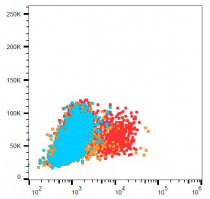ARG10096
anti-HLA G antibody [87G] (Biotin)
anti-HLA G antibody [87G] (Biotin) for ELISA,Flow cytometry and Human
Immune System antibody
Overview
| Product Description | Biotin-conjugated Mouse Monoclonal antibody [87G] recognizes HLA G |
|---|---|
| Tested Reactivity | Hu |
| Species Does Not React With | Ms, Rat |
| Tested Application | ELISA, FACS |
| Specificity | The clone 87G recognizes both membrane-bound and soluble forms of HLA-G (HLA-G1 and HLA-G5). HLA-G belongs to the MHC Class I molecules (MHC Class Ib; nonclassical) and it is expressed on the surface of trophoblast cells. 87G blocks interaction of HLA-G with inhibitory receptors. |
| Host | Mouse |
| Clonality | Monoclonal |
| Clone | 87G |
| Isotype | IgG2a |
| Target Name | HLA G |
| Antigen Species | Human |
| Immunogen | HLA-B27 transgenic mice were imunized with H-2 identical murine cells transfected with and expressing genes encoding HLA-G and human beta2-microglobulin. |
| Conjugation | Biotin |
| Alternate Names | HLA G antigen; MHC class I antigen G; HLA class I histocompatibility antigen, alpha chain G; MHC-G |
Application Instructions
| Application Suggestion |
|
||||||
|---|---|---|---|---|---|---|---|
| Application Note | * The dilutions indicate recommended starting dilutions and the optimal dilutions or concentrations should be determined by the scientist. |
Properties
| Form | Liquid |
|---|---|
| Purification Note | The purified antibody is conjugated with Biotin-LC-NHS under optimum conditions. The reagent is free of unconjugated biotin. |
| Buffer | PBS (pH 7.4) and 15 mM Sodium azide |
| Preservative | 15 mM Sodium azide |
| Concentration | 1 mg/ml |
| Storage Instruction | Aliquot and store in the dark at 2-8°C. Keep protected from prolonged exposure to light. Avoid repeated freeze/thaw cycles. Suggest spin the vial prior to opening. The antibody solution should be gently mixed before use. |
| Note | For laboratory research only, not for drug, diagnostic or other use. |
Bioinformation
| Database Links |
Swiss-port # P17693 Human HLA class I histocompatibility antigen, alpha chain G |
|---|---|
| Gene Symbol | HLA-G |
| Gene Full Name | major histocompatibility complex, class I, G |
| Background | HLA-G belongs to the HLA class I heavy chain paralogues. This class I molecule is a heterodimer consisting of a heavy chain and a light chain (beta-2 microglobulin). The heavy chain is anchored in the membrane. HLA-G is expressed on fetal derived placental cells. The heavy chain is approximately 45 kDa and its gene contains 8 exons. Exon one encodes the leader peptide, exons 2 and 3 encode the alpha1 and alpha2 domain, which both bind the peptide, exon 4 encodes the alpha3 domain, exon 5 encodes the transmembrane region, and exon 6 encodes the cytoplasmic tail. [provided by RefSeq, Jul 2008] |
| Function | Involved in the presentation of foreign antigens to the immune system. Plays a role in maternal tolerance of the fetus by mediating protection from the deleterious effects of natural killer cells, cytotoxic T-lymphocytes, macrophages and mononuclear cells. [UniProt] |
| Research Area | Immune System antibody |
| Calculated MW | 38 kDa |
Images (1) Click the Picture to Zoom In






